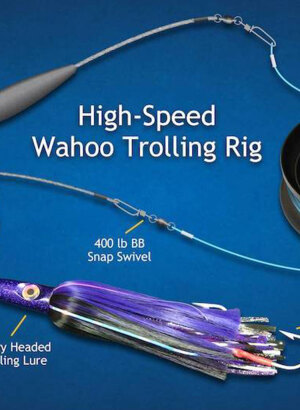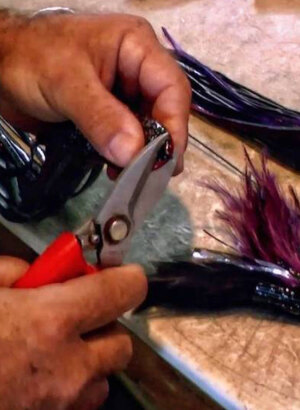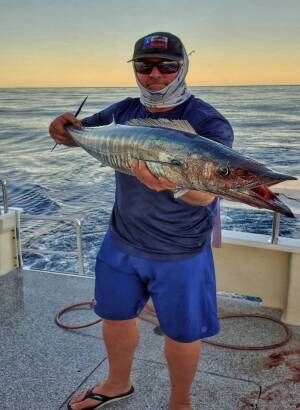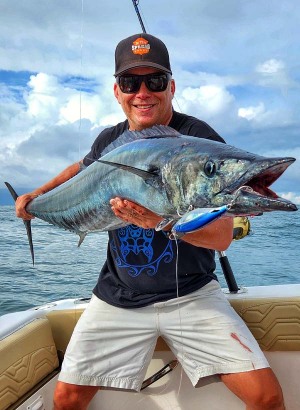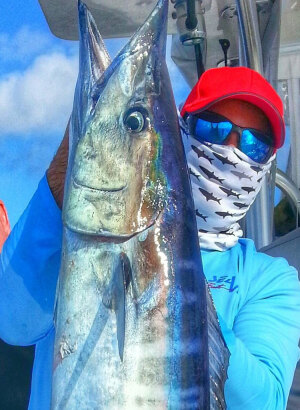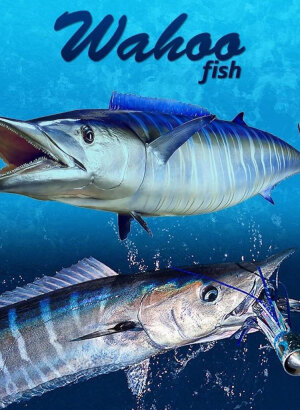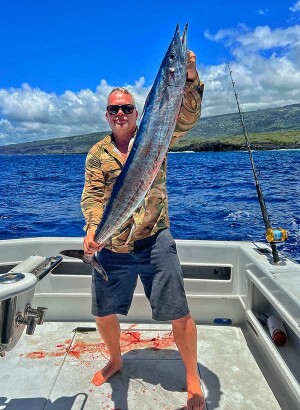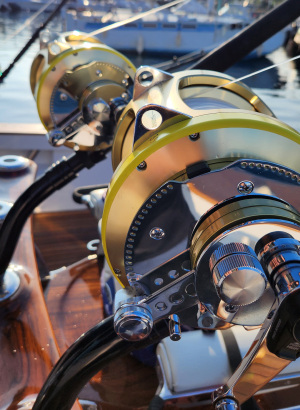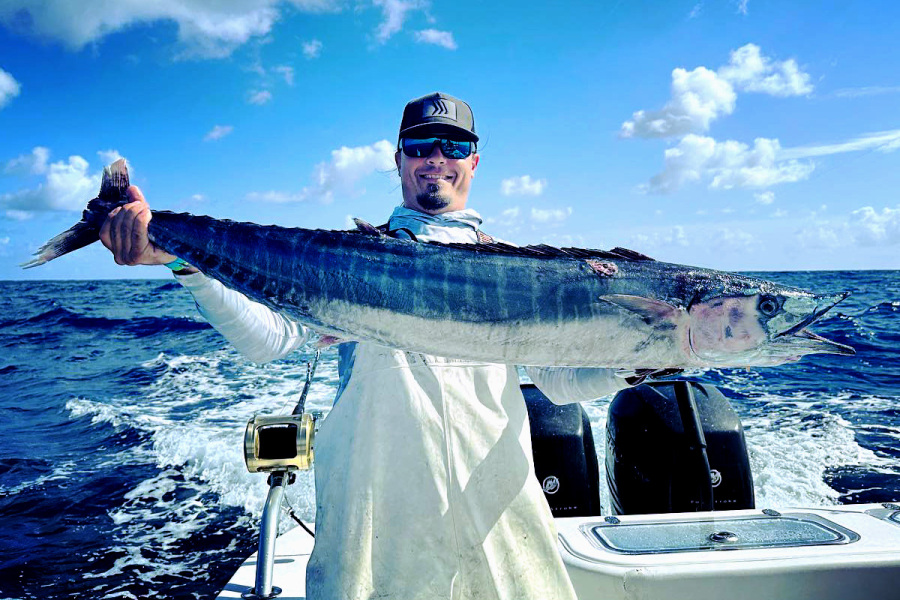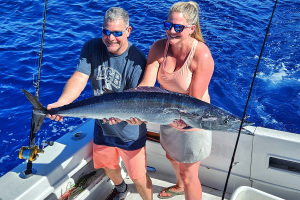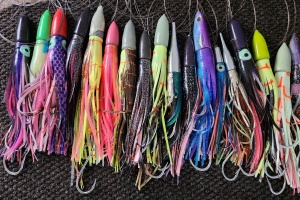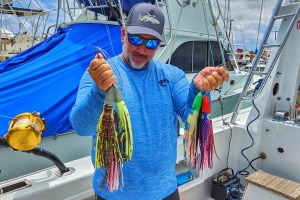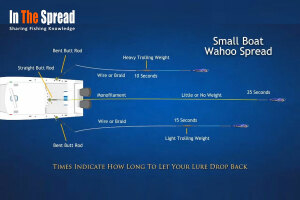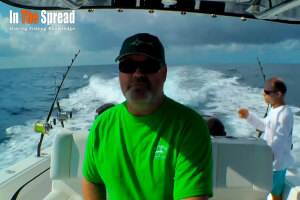Master the art of wahoo fishing with tailored strategies blending live and dead baits. Adapt to seasonal baitfish trends, water conditions, and local insights for ultimate success. Learn to balance bait choice with hands-on experimentation and community knowledge, refining tactics for each outing. Your path to wahoo mastery lies in observation and adaptability.
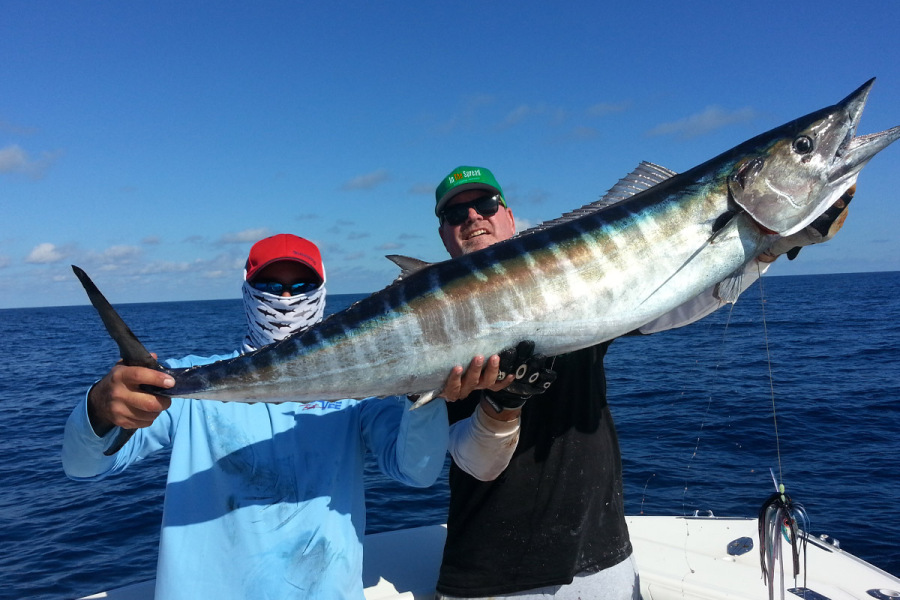
Best Bait for Wahoo
- First, consider live bait – the connoisseurs' choice. The use of blue runners, scad, bonito, herring, or pinfish isn't just fishing; it's an art form. Drifted or trolled slowly, these baits aren't just food; they're a siren song for wahoo, tapping into their primal urges. Live bait, with its erratic movements, mirrors the unpredictability of life itself. It's about creating a scenario so enticing that the wahoo can't help but give in to its instincts. This method requires patience and finesse, qualities that separate the amateur from the maestro.
- On the flip side, there's dead bait – the pragmatist's preference. Ballyhoo, bonito, flying fish or squid might not have the flair of live bait, but they bring consistency and control. This approach is about strategy, planning, and preparation. It's a testament to human ingenuity, rigging dead bait in ways that maximize appeal and durability. Here, the angler becomes an inventor, a tactician using speed and ingenuity to outsmart a creature honed by millions of years of evolution.
The debate between live and dead bait is more than just a choice of fishing tactics. It's a reflection of the angler's philosophy, a decision that speaks to their relationship with the ocean and its inhabitants. The ocean, like life, is unpredictable and full of mysteries. The key isn't finding a definitive answer to which bait is superior; it's embracing the journey of discovery. It's about experimenting, learning from each cast, and ultimately understanding that the pursuit of the wahoo, like life's own pursuits, is a journey that never truly ends. Each bait, each technique, and each expedition offers a unique story, a chance to learn and grow. In the end, the choice of bait becomes a personal narrative, a chapter in the angler's ongoing saga with the sea.

Wahoo Diet
The wahoo, a culinary connoisseur of the ocean, exhibits a dietary palette as diverse and complex as any top-tier epicurean. Their feeding habits are not just a matter of survival but a fine-tuned art of selection and strategy, shaped by the dynamic theater of the sea.
Small Fish and Squid: The Main Course
Imagine the wahoo's diet as an elaborate menu, with squid and various fish featuring as the main courses. The wahoo, akin to a gourmet seeking out specific flavors, shows a distinct preference for frigate mackerel, butterfish, porcupine fish, and round herring. Each of these species offers unique nutritional benefits, contributing to the wahoo's robust health and vigor. The squid, a staple in this marine banquet, provides a rich source of protein and fat, essential for the high-energy lifestyle of the wahoo.
The Art of Opportunistic Feeding
- Small Pelagic Fish: These are like the appetizers in the wahoo's diet. Schooling fish such as anchovies, herring, sardines, and menhaden are not just meals; they are energy-packed snacks that fuel the wahoo's rapid pursuits.
- Crustaceans and Squid: Here, the wahoo's diet shows its versatility. Feasting on shrimp, crabs, and squid, especially at night when these creatures venture near the surface, the wahoo demonstrates its adaptability and preference for variety.
- Other Predators: The wahoo's diet also includes a surprising element – other predators like smaller tuna, mahi-mahi, and jacks. In the competitive oceanic ecosystem, the wahoo proves itself not just as a hunter but a strategist, capitalizing on the vulnerable and the weak.
Dietary Variations: A Reflection of Environment and Growth
A Study in Adaptability
Feeding Behavior
- Fast Attacks - The Blitzkrieg of the Ocean: Imagine a torpedo with fins, and you have the wahoo. Capable of clocking speeds over 60 mph, these aquatic athletes use their blistering velocity to ambush prey, showcasing a level of agility that rivals the most advanced military maneuvers. This isn't just speed for the sake of speed; it's strategic, calculated, and executed with a precision that leaves their prey little chance of escape. The wahoo's ability to chase down nimble targets like tuna and mackerel is akin to a top-tier athlete outperforming their competition – it's a display of raw power and finesse.
- Pack Hunting - The Underwater Wolves: When wahoos hunt in packs, they transform into the wolves of the sea. Their coordinated assaults on schools of smaller fish are a testament to their social intelligence and hunting acumen. This isn't random chaos; it's a well-orchestrated symphony of predators working in unison. By corralling baitfish into tight clusters, they turn a scattered group of prey into a concentrated buffet, taking turns to strike with precision and efficiency.
- Feeding Frenzy Behavior - The Ocean's Wild Rave: During a feeding frenzy, the wahoo's behavior shifts gears into something more primal, more visceral. As they slash through schools of bait, their golden sides flashing red in the heat of the hunt, they become less like fish and more like force of nature. In these moments, their strikes are rapid, relentless, and indiscriminate – a chaotic ballet set to the rhythm of survival.
- Cannibalism - The Dark Side of Dominance: In a twist that underscores the harsh realities of the ocean, wahoos engage in cannibalism. The larger, more dominant wahoos don't shy away from feeding on their younger counterparts. This behavior reflects the wahoo's relentless drive to survive and thrive, constantly pushing the boundaries of their feeding habits to adapt and conquer.
- Rise Feeding - Hunters of the Twilight: As dusk falls and dawn breaks, wahoos turn their attention to the vertical dance of prey moving towards the ocean's surface. They are adept at exploiting these daily migrations, using the dim light to their advantage. This rise feeding behavior showcases their adaptability, their ability to switch hunting strategies to suit the changing environment.
The Wahoo: A Predator Par Excellence
In essence, wahoos are not just fish; they are apex predators sculpted by evolution to excel in the open ocean. Their feeding strategies – from lightning-fast attacks to coordinated pack hunting, from frenzied assaults to exploiting cannibalistic opportunities – reflect a complex and dynamic approach to survival. Each burst of speed, each strategic hunt, and each frenzied attack is a testament to the wahoo's role as an impressive and aggressive predator of the seas. Their life is a continuous quest for sustenance, executed with a combination of speed, strength, and intelligence that places them among the ocean's most formidable hunters.
Live Bait
Advantages
- The Irresistible Allure of Natural Scent and Movement: Live baits, be it mullet, bonito, or tuna, bring an authenticity to the table that's hard to replicate. They emit natural scents and display erratic movements that mimic wounded prey, a siren call to the wahoo's deep-seated predatory instincts. These scents and movements aren't just triggers; they're invitations to a feast, tapping directly into the primal urges that drive these apex predators.
- Provoking the Hunter - Aggressive Responses from Wahoo: The action and vibration of live bait in the water are like a red flag to a bull for wahoos. These vibrations, undetectable to the human eye but a beacon to the wahoo's keen senses, often result in more aggressive and decisive bites. It's not just a bite; it's a statement of intent, a declaration of the wahoo's predatory prowess.
- Attracting the Titans - Targeting Trophy Wahoo: For those in pursuit of the giants, the larger specimens of wahoo, live baits offer an edge. The scent trails and visual allure of a struggling larger bait like a bonito or large mullet can captivate trophy-sized wahoos. These baits aren't just food; they're trophies in themselves, promising a worthy challenge to the hunter.
- The Art of Live Bait Fishing for Wahoo - Movement: The chaotic dance of live bait, akin to an injured or fleeing prey, is a spectacle that wahoos find irresistible. This commotion, whether it's a frantically swimming ballyhoo or a struggling mullet, is a key trigger for eliciting those explosive strikes.
- Vibration: The subtle vibrations emitted by live baits, a signal of struggle and vulnerability, play a critical role in attracting wahoos. These vibrations, undetectable to us but a dinner bell for wahoos, leverage their acute lateral line senses.
- Scent: Olfactory cues play a massive role in the wahoo's world. The distinct scents of live baits like sardines or herring create a chemical trail that wahoos can't ignore. It's a scent-based homing device, guiding them straight to the source.
- Hookset: Live bait offers an advantage in hookset efficiency. Wahoos, when striking live prey, are more likely to hook themselves due to their aggressive feeding style, leading to higher hookup ratios compared to dead baits or artificial lures.
- Durability: In the marathon of trolling, live baits outperform their dead counterparts in endurance. They maintain their lively appeal longer, ensuring a persistent and enticing presence in your trolling spread.
Disadvantages
- Finding and Keeping Alive: The first hurdle in using live bait is sourcing it. Catching live mullet, blue runner, or threadfin is an art in itself, requiring not just knowledge of their habitats but also the skill to catch them in ample quantities. For those less inclined to catch their own, bait shops can be a hit-or-miss affair, with unpredictable availability and selection.
- Maintenance: Once caught, the challenge shifts to keeping these baits alive and vigorous. This isn't just about throwing them in a tank; it requires a miniature ecosystem of circulating water, aeration, and temperature control. A single misstep in this delicate balance can lead to a tank of lifeless bait, rendering the entire effort futile.
- Purchasing Live Bait: While sourcing your own bait can mitigate costs, purchasing live bait like ballyhoo or herring from suppliers can quickly become a costly affair. Especially in tournament scenarios where bulk is necessary, the expenses can mount rapidly. Seasonal fluctuations in bait availability can further complicate this.
- DIY Bait Catching: Opting to catch live bait oneself involves its own set of costs, including cast nets, chum, additional fuel for nearshore trips, and specialized bait pens. These investments, while potentially reducing per-trip costs, add up over time, making this a less economical option than it might initially seem.
- Tackle and Technique: Presenting live bait to wahoo, particularly when trolling at depth, requires a specific set of gear – from planers and skirts to weights and outriggers. The rigging process is a delicate art, demanding precision and finesse. Incorrect rigging can lead to bait spinning, line tangling, or premature bait death.
- Experience and Skill: This level of rigging is not for the faint-hearted or inexperienced. It takes a seasoned hand to keep baits swimming enticingly and effectively, a skill that often comes with time and practice.

Popular Live Baits
- Characteristics: Resembling anchovies or sardines, scad travel in dense schools. These small baitfish are a staple in the wahoo's diet.
- Availability: Found abundantly in warm waters, scad are easily harvested with cast nets, making them a convenient option for anglers.
- Appeal: Their presence in schools makes them a natural target for wahoo, who often prey on such formations.
Frigate Mackerel (Auxis thazard): The Speedster
- Profile: Known for their streamlined shape and notable speed, frigate mackerel average around 8 inches in length.
- Attraction: Their larger size makes them an appealing meal for trophy wahoo, offering a substantial bite that promises a satisfying hunt.
- Tactic: Trolling frigate mackerel at high speeds mimics their natural quick movements, triggering the wahoo's instinct to chase.
- Traits: Part of the tuna family and closely related to wahoo, these fish boast a muscular build and range from 12-16 inches.
- Durability: Their strength keeps them lively on the line for extended periods, ensuring a consistent and enticing presentation.
- Strike Provocation: Their size and vigor make them prime candidates for eliciting big strikes from wahoo.
- Varieties: Whether Atlantic, Pacific, or Eastern Pacific, bonitos share common traits of erratic darting action and bright silver flashes.
- Size: Averaging 2-5 pounds, they maintain vigor on troll lines for a considerable duration.
- Lure: The erratic movements and flashy appearance of bonito are particularly enticing to wahoo, keying in on their predatory senses.
- Popularity: A top choice for offshore gamefishing, ballyhoo are known for their unique dorsal fin and side-to-side swimming action.
- Ease of Catch: They can be caught in large quantities and are a readily available option for anglers.
- Trolling Suitability: Ballyhoo maintain their allure for hours when trolled at faster speeds, ideal for wahoo fishing.
Dead Bait
Advantages
- Ease of Obtaining: Unlike the chase and maintenance required for live bait, dead baits such as mackerel, bonito, mullet, or ballyhoo are readily available, often frozen, at tackle shops and marinas.
- Storage Simplicity: The logistics of stocking up on dead bait are straightforward – they can be easily stored in a boat's freezer, ready for use on long offshore trips. This eliminates the need for the complex and time-consuming process of keeping bait alive.
- Affordability: On a cost front, dead bait is typically more wallet-friendly than live bait, especially when considering the expense and scarcity of sourcing live bait in bulk.
- Repeat Use: The ability to thaw and use a bag of dead bait repeatedly as needed adds to its economic viability, making it a practical choice for extended fishing excursions.
- Reduced Damage: Dead baits, by virtue of their nature, don't suffer the wear and tear of movement against tank walls or equipment, nor the aggression of cohabiting baitfish. This makes them more durable over the course of a long day’s trolling.
- Longevity: The intact state of dead baits during trolling contributes to their effectiveness, ensuring they remain appealing to wahoo for longer periods.
- Attractors and Marinades: Dead baits offer the unique advantage of customization. Anglers can apply various scent attractants, inject marinades, or use bait dressing oils to enhance their appeal.
- Added Action: Further customizing dead baits with darting skirts, attaching strips, or other modifications adds action and visual appeal, an option not feasible with live bait.
Disadvantages
- Sensory Appeal: Dead baits, while convenient, lack the natural scents, sounds, electrical pulses, and vibrant colors emitted by living baitfish. These elements are crucial in attracting current-feeding wahoos, which rely heavily on these cues to home in on prey.
- Triggering Instincts: The absence of liveliness in dead baits often fails to trigger the wahoo's natural hunting instincts as effectively as live bait. It's the difference between a static display and a dynamic performance.
- Feeding Frenzy: While wahoos may attack dead baits, these baits often lack the erratic movements that incite fierce strikes. Live baits, with their unpredictable and lively motions, tend to provoke more committed and aggressive responses from wahoos.
- Hook-Up Ratios: The level of attack commitment from wahoo is typically higher with live bait, resulting in better hook-up ratios. The vigorous chase of live prey taps into their predatory nature more profoundly.
- Appeal to Larger Wahoo: Smaller wahoos may find dead bait appealing, but their lack of vigorous movement and diminished sensory cues can make them less effective in attracting larger, more discerning wahoo.
- Predator Enthusiasm: If a dead bait doesn’t move or feel like live prey, even the largest and most opportunistic wahoo might be less inclined to strike, potentially bypassing what they perceive as an unworthy target.
- Structural Integrity: Dead baits, when subjected to the aggressive strikes of wahoo, particularly their razor-sharp teeth, tend to suffer significant damage. This includes shredded tails or bites to the midsection.
- Repeated Use: Due to this susceptibility to damage, dead baits often require more frequent replacement, diminishing their durability and long-term effectiveness during a day’s trolling.
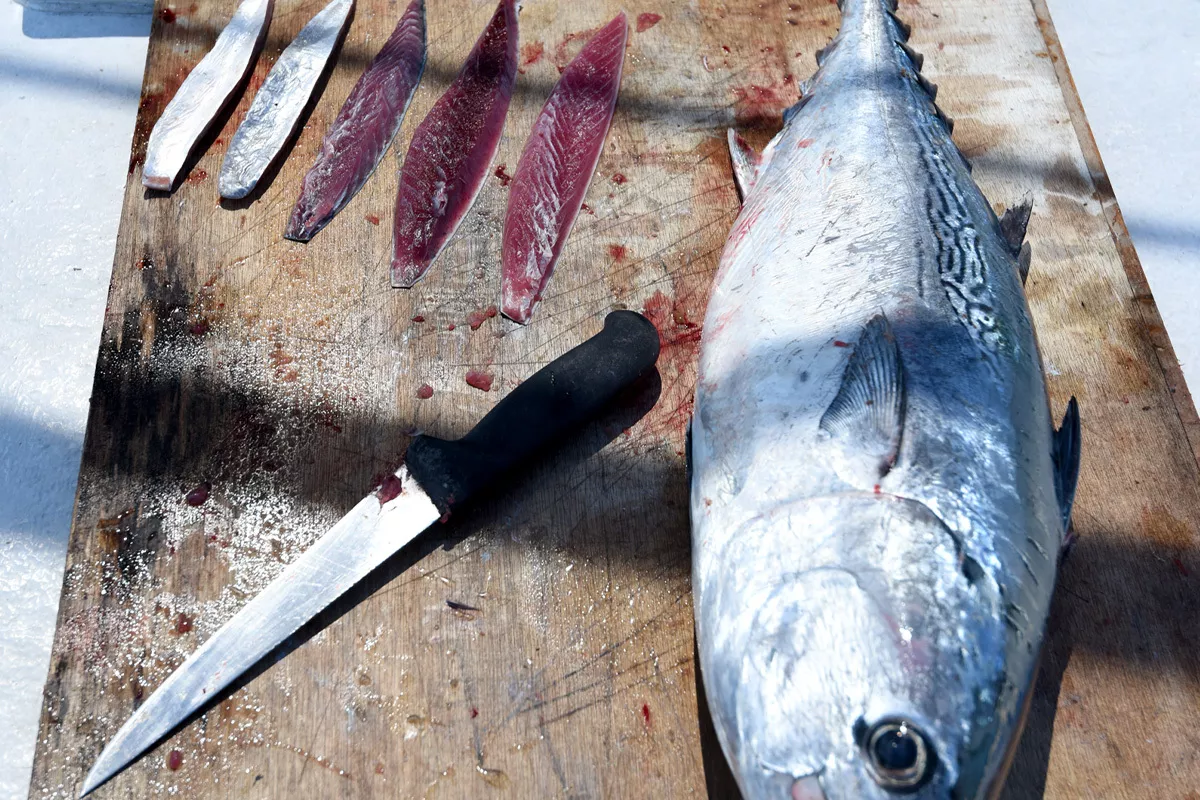
Popular Dead Baits
- Preparation: Crafted from bonito fillets, these thin vertical slices are more than just pieces of fish; they're designed to mimic the natural undulation of fleeing baitfish.
- Attraction Factor: The inherent blood and oils released from the bonito strips enhance their effectiveness, creating a sensory trail that is hard for wahoo to resist.
- Tactical Use: When trolled, these strips dance through the water, imitating the vulnerable, erratic movement of prey, tapping into the wahoo’s predatory instincts.
- Design: Similar in concept to bonito strips, these slender slices of ballyhoo flesh are a masterclass in simplicity and effectiveness.
- Allure: Their fluttering action in the water, combined with the dispersion of scent, creates an irresistible target for wahoo.
- Ease of Use: Not only are they effective, but ballyhoo strips are also easy to cut and secure to hooks, offering a convenient option for anglers.
- Rigging: A full ballyhoo, skewered from nose to tail on a hook and adorned with a swirling plastic skirt, presents an enticing silhouette to big game predators.
- Action: This setup, often paired with an Ilander-style skirt, offers built-in action at trolling speeds, simulating the long, sleek profile of typical wahoo prey.
- Effectiveness: While not as dynamic as live bait, the whole ballyhoo’s silhouette and movement make it a staple in wahoo fishing arsenals.
- Variety: From metal lures to plastic swimbaits, these creations are engineered to mimic wounded baitfish with erratic actions.
- Examples: Lead heads, jet heads, Rapala magnums, or Nomad Minnows are common choices, each offering a unique swimming action.
- Strike Induction: Though they may not match the effectiveness of natural bait in certain scenarios, their lifelike action can still tempt wahoo to strike.
Level Up Your Wahoo Fishing Tactics
The Art of Dead Bait Presentation
- Tactical Rigging: The way you rig your dead bait can make all the difference. Using techniques like bridling or adding weights strategically can impart a lifelike movement to the bait, mimicking the erratic swimming of an injured fish.
- Trolling Speeds: Adjusting trolling speeds to match the natural speed of the baitfish you’re imitating is crucial. It’s about finding that sweet spot where the bait dances and darts through the water, enticing the wahoo to strike.
- Enhanced Baits: Infusing dead baits with additional scents or using scent-emitting products can create an invisible trail in the water, playing on the wahoo’s acute sense of smell.
- Natural Oils: Even the natural oils and blood from the dead bait can be a potent attractor, forming a scent trail that wahoos find irresistible.
- Bait Selection: Choosing the right size and type of dead bait is a strategic decision. It should closely resemble the wahoos' natural prey in both size and profile.
- Visual Appeal: Adding skirts or other visual attractors can enhance the bait's appeal, making it more noticeable and attractive to the wahoo.
- Predatory Instincts: Wahoo are hardwired to respond to certain stimuli. Presenting dead bait in a way that triggers these instincts is a psychological ploy, playing into their natural behaviors and tendencies.
- Strike Zone: Knowing where and how wahoo strike their prey can help in presenting the bait in the most effective manner, increasing the chances of a successful hook-up.
- Experience and Observation: The most successful anglers are those who learn from each outing. Observing how wahoo respond to different presentations and adapting accordingly is key.
- Continuous Learning: No two days on the water are the same. Each trip is an opportunity to refine techniques and deepen understanding of this majestic predator.
Tips for Selecting the Best Bait
- Seasonal Baitfish: Understand the seasonal variations in baitfish in your area. What thrives in summer may not be around in winter. Tailor your bait selection to mimic these prevalent species.
- Water Conditions: Pay attention to water temperature and currents. These factors significantly impact where baitfish congregate. Finding and mirroring these bait concentrations can lead to more successful outings.
- Small vs. Large Baits: Smaller baits in the 5-7 inch range tend to attract smaller male wahoos and the occasional trophy. But if you're aiming for larger catches, baits in the 8-12 inch range can be more effective.
- Bait Size and Wahoo Size: There's a correlation between the size of your bait and the size of the wahoo you're likely to hook. Bigger baits generally mean bigger fish, especially if you're hunting for trophies or a substantial catch.
- Local Variations: Each offshore area has its idiosyncrasies. What works in one region may not in another. Experiment with different types of live and dead baits to see what garners the best action and hookups.
- Trial and Error: Keep experimenting until you find the bait that consistently delivers results. This trial-and-error approach is essential in fine-tuning your strategy.
- Covering All Bases: Using a mix of live and dead baits allows you to cater to the wahoo's varying appetites. This approach increases your chances of triggering a strike.
- Responsive Strategy: Observe which type of bait - live or dead - is getting more attention on any given day. The wahoo's preference can change based on numerous factors, including weather, water conditions, and their feeding patterns.
- Log Your Successes (and Failures): Keep detailed notes on what works and what doesn’t. Over time, these notes can reveal patterns and preferences specific to your fishing spots.
- Continuous Learning: Fishing for wahoo is a continuous learning process. What you learn from one trip can immensely improve your strategy on the next.
Conclusion
Seth Horne In The Spread, Chief Creator

